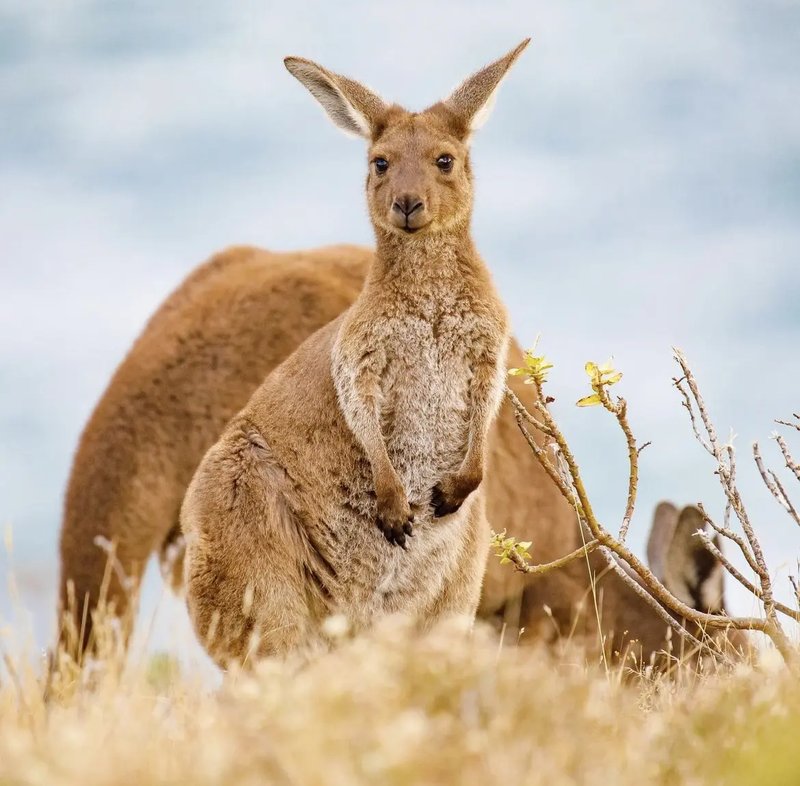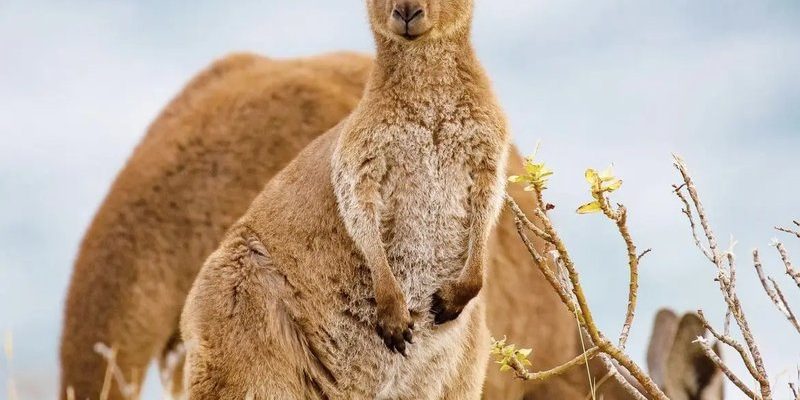
Kangaroos are one of Australia’s most iconic animals. With their powerful hind legs and long tails, they almost seem to embody the spirit of the Australian outback. Picture this: hopping gracefully across the sunburnt land, these creatures are both fascinating and a bit quirky. Their unique way of moving, using those strong legs, helps them navigate their natural habitat efficiently while conserving energy. When you think of kangaroos, you might picture them bounding across vast plains, or perhaps even resting in the shade of a bush on a hot day. But there’s so much more to these remarkable marsupials!
But why are they so special? It’s not just their impressive jumping ability or their adorable joeys peeking out of their pouches. Kangaroos are a symbol of Australia, found nowhere else in the world. They’re an intriguing blend of beauty and power, deeply intertwined with the culture and environment of Australia. So let’s hop into the fascinating world of kangaroos and discover what makes them truly unique.
Physical Characteristics
Kangaroos are known for their distinctive features. They have large, muscular bodies supported by strong hind legs that can propel them at incredible speeds. Depending on the species, they can vary in size. The largest kangaroo, the red kangaroo, can stand over six feet tall and weigh up to 200 pounds. That’s taller than most of us! Their long tails are used for balance while hopping and can also serve as a fifth limb when moving slowly or grazing.
The thick fur of a kangaroo is typically a blend of brown, grey, or sometimes even reddish tones, which helps them blend into their surroundings. You might not know this, but they have keen eyesight and a sharp sense of smell, both essential for detecting predators. With their large, expressive eyes, kangaroos exhibit a range of emotions. It’s fascinating to observe how their body language communicates everything from curiosity to wariness.
Habitat and Distribution
Kangaroos are primarily found in Australia, where they thrive in a variety of environments ranging from open grasslands to dense forests. You’ll see them most commonly in the dry, arid regions of the outback, but you can also find them in more populated areas. They’ve adapted well to different climates, showcasing their resilience as a species. This adaptability is a big part of why they flourish in Australia, despite the challenges of their environment.
Interestingly, kangaroos also inhabit Tasmania and some offshore islands. Their presence has been influential in shaping the ecosystems they inhabit. For instance, as they graze on grasses, they help maintain the health of the landscape, allowing new plants to grow while ensuring that the grass doesn’t become too overgrown.
Diet and Feeding Habits
As herbivores, kangaroos primarily feed on a diet of grasses and leaves. They have a specialized digestive system that allows them to break down tough plant materials efficiently. This process is quite interesting and involves fermentation in their large cecum, a part of their intestines. You might say their stomachs are like little fermentation factories! This ability lets them extract the maximum amount of nutrients from the fibrous plants they consume.
You might wonder how often kangaroos eat. They typically graze early in the morning and later in the evening when temperatures are cooler. This behavior helps them avoid the harsh midday heat. In fact, kangaroos can go for long periods without water, getting most of the hydration they need from their food. Isn’t that impressive? It shows how perfectly adapted they are to their surroundings.
Social Behavior and Reproduction
Kangaroos are social creatures and often live in groups called mobs. A mob can consist of just a few individuals or up to 100 kangaroos. Living in a group offers protection from predators, as there’s safety in numbers. You might find it fascinating how they communicate with one another through a range of sounds and body movements, from soft grunts to thumping their tails on the ground to signal alarm.
Reproduction in kangaroos is quite unique due to their marsupial nature. Female kangaroos give birth to tiny, underdeveloped joeys, which then crawl into their mother’s pouch to continue developing. This pouch acts like a cozy nursery, allowing joeys to nurse and grow in safety. It’s a heartwarming sight to see these tiny creatures poking their heads out of the pouch as they grow! The whole process often brings a smile to those lucky enough to witness it.
Fun Facts About Kangaroos
| Species: | Eastern Grey, Red, Antilopine, and more |
| Size: | Up to 6 feet tall (Red Kangaroo) |
| Weight: | Up to 200 pounds (Red Kangaroo) |
| Lifespan: | Up to 20 years in the wild |
| Speed: | Up to 35 miles per hour |
| Diet: | Herbivorous (grasses, leaves) |
Conservation Status
Many kangaroo species are stable, but some face threats from habitat loss, hunting, and climate change. It’s essential to keep an eye on their populations to ensure they remain a part of Australia’s natural heritage. Conservation efforts are in place to protect their habitats and ensure they have safe spaces to thrive. Organizations work tirelessly to educate the public about these magnificent creatures and the challenges they face. It’s a reminder of our responsibility to support wildlife conservation and preserve the beautiful ecosystems that kangaroos call home.
Additionally, by advocating for responsible land use and sustainable practices, we can contribute positively to the environment. As the world changes, protecting kangaroos and their habitats becomes even more crucial. It’s a team effort, and every little action counts!
Kangaroos are more than just a cute face with big feet. They’re a vital part of Australia’s ecosystem and culture. From their fascinating physical adaptations to their unique social structures, these creatures capture our imagination. It’s heartening to know that people are working hard to ensure that future generations will be able to appreciate the kangaroo just as we do today. So next time you think of kangaroos, remember that they’re not only symbols of Australia but also key players in maintaining the delicate balance of nature. They truly are remarkable animals!
FAQ
What do kangaroos eat?
Kangaroos primarily eat grasses and leaves. Their herbivorous diet requires them to graze for hours each day. They are well-adapted to digest tough plant materials thanks to their unique digestive systems that allow for fermentation, making the most out of their fibrous meals.
How fast can kangaroos run?
Kangaroos can reach impressive speeds of up to 35 miles per hour. They are built for speed, with powerful hind legs that allow them to cover large distances quickly and efficiently, especially when escaping from predators.
How long do kangaroos live?
In the wild, kangaroos can live up to 20 years. However, their lifespan can be shorter due to predation and environmental factors. In captivity, with proper care, they may live even longer.
Are kangaroos dangerous?
While kangaroos are generally not aggressive, they can become defensive if they feel threatened. It’s important to respect their space, especially when they are with joeys. A female kangaroo can be particularly protective, so it’s best to observe them from a safe distance.
Do kangaroos have predators?
Kangaroos face threats from various predators, including dingoes and large birds of prey when they are young or weak. Humans also pose a significant threat through habitat destruction and hunting. Conservation efforts are essential to protect them from these dangers.
How do kangaroos reproduce?
Kangaroo reproduction is fascinating due to their marsupial nature. After a gestation period of about 30 to 40 days, the tiny joey is born and crawls into the mother’s pouch, where it continues to develop for several months.
Are kangaroos social animals?
Yes, kangaroos are social creatures and often live in groups called mobs. This social structure helps protect them from predators and provides support in finding food and navigating their environment.
Can kangaroos swim?
Kangaroos are surprisingly good swimmers! If they find themselves in water, they can paddle with their limbs and can swim across rivers to escape danger or explore new areas.
What is the difference between a kangaroo and a wallaby?
While both are marsupials and belong to the same family, kangaroos are generally larger than wallabies. Wallabies also have shorter legs and are more likely to inhabit dense vegetation, while kangaroos are more adapted to open spaces.
Do kangaroos have a mating season?
Kangaroo mating can occur year-round, but it often peaks during the spring months. This timing helps ensure that joeys are born during the warmer months when food is more abundant, improving their chances of survival.
How do kangaroos communicate?
Kangaroos communicate through a variety of sounds, including soft grunts and hisses. They also use body language, such as thumping their tails or specific postures, to signal different emotions to their mob mates.
Where can I see kangaroos in the wild?
To see kangaroos in the wild, you might visit national parks or reserves in Australia, particularly places like Kangaroo Island or the grasslands of the outback. Keep your eyes peeled during early mornings or late afternoons when they’re most active!
Is it legal to keep a kangaroo as a pet?
In many places, keeping a kangaroo as a pet is illegal or heavily regulated due to their wild nature and specific habitat needs. It’s always best to appreciate these animals in their natural environments or through reputable wildlife parks.
What can I do to help protect kangaroos?
You can help protect kangaroos by supporting conservation efforts, understanding their habitat needs, and spreading awareness about their situation. Reducing plastic use and engaging in responsible practices can also positively impact their ecosystems.

